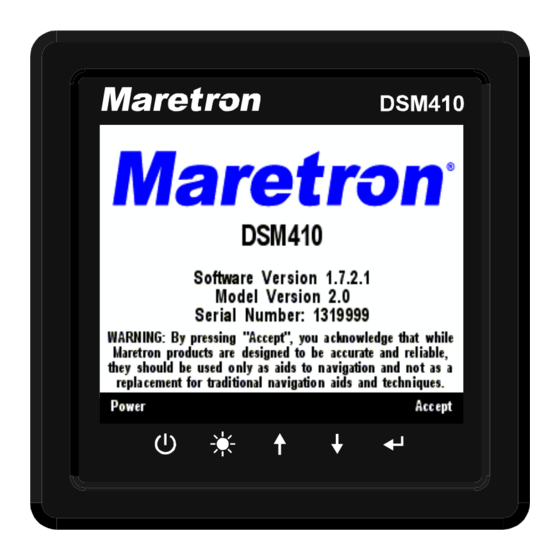
Maretron DSM410 Manuals
Manuals and User Guides for Maretron DSM410. We have 1 Maretron DSM410 manual available for free PDF download: User Manual
Maretron DSM410 User Manual (289 pages)
NMEA 2000 Multi-function Color Graphic
Table of Contents
-
General17
-
Introduction17
-
Installation18
-
AC Bus26
-
AC Generator26
-
AC Utility27
-
Anchor Watch28
-
Depth28
-
Electrical28
-
Engine29
-
Environment30
-
Fluid Flow30
-
Gps32
-
Heading32
-
Humidity32
-
Indicator32
-
Mechanical33
-
Motion33
-
Navigation33
-
Rudder34
-
Speed34
-
Tank35
-
Temperature35
-
Time/Date35
-
Transmission36
-
Vdr36
-
Vessel36
-
Wind36
-
Alerts38
-
Alert Types38
-
Alert States39
-
Menu Mode42
-
Alert Status43
-
Units Menu57
-
Control Mode61
-
Trip Log70
-
Label76
-
Instance79
-
Label79
-
DC Type87
-
Instance89
-
Label89
-
Device Label92
-
Instance92
-
Label102
-
Trip Log106
-
Trip Log112
-
Engine Instance113
-
Device Label120
-
Operating Mode120
-
Channel #0120
-
Channel #1125
-
Channel #0-5131
-
Cold Start GPS143
-
GPS Mode Setting143
-
Device Label144
-
Cold Start GPS148
-
Device Label148
-
Device Label153
-
Dhcp153
-
IP Address154
-
Subnet Mask154
-
Default Gateway154
-
Default DNS154
-
Device Label158
-
Label164
-
Rudder Number168
-
Operating Mode169
-
Device Label173
-
Instance174
-
Device Label176
-
Instance177
-
Label179
-
Test180
-
Label186
-
Label193
-
Tank Capacity193
-
Tank Number199
-
Tank Type199
-
Operating Mode200
-
Label204
-
Tank Capacity204
-
Tank Number210
-
Tank Type210
-
Device Label213
-
Label217
-
Password217
-
Dhcp217
-
IP Address217
-
Subnet Mask217
-
Default Gateway218
-
Default DNS218
-
Device Label220
-
Outside Humidity224
-
Bar Graph227
-
Date229
-
Date/Time229
-
Gauge Display230
-
Indicator Light232
-
Numeric Display234
-
Rolling Road236
-
Line Graph238
-
SMS Status238
-
Time (Hh:MM)239
-
Time (Hh:MM:ss)239
-
VDR Status240
-
Weather Display240
-
Wind Rose242
-
Alerts249
-
Adding an Alert251
-
Alert Type252
-
Priority252
-
Trigger Source253
-
Description253
-
Location253
-
Local Audible267
-
Tone268
-
Scope270
-
Editing an Alert272
-
Flashing Screen278
-
Maintenance279
-
Troubleshooting280
Advertisement
Advertisement
